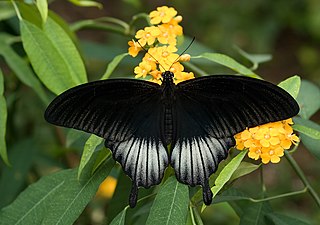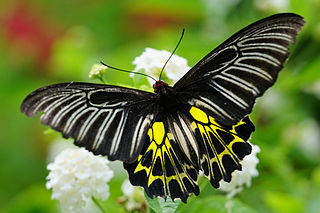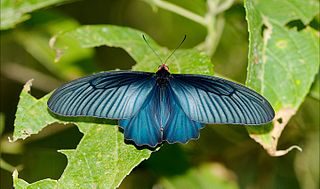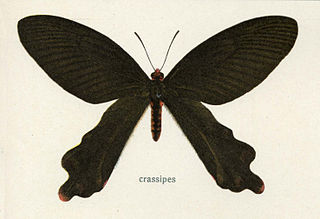
Papilio memnon, the great Mormon, is a large butterfly native to southern Asia that belongs to the swallowtail family. It is widely distributed and has thirteen subspecies. The female is polymorphic and with mimetic forms.

Graphium nomius, the spot swordtail, is a butterfly found in South and Southeast Asia that belongs to the swallowtail family. The species was first described by Eugenius Johann Christoph Esper in 1793. One of the grandest sights is a host of spot swordtails mud-puddling or swarming around a flowering forest tree.

Byasa dasarada, the great windmill, is a butterfly found in India that belongs to the windmills genus, Byasa, comprising tailed black swallowtail butterflies with white spots and red submarginal crescents.

Papilio alcmenor, the redbreast, is a species of swallowtail butterfly found in South Asia.

Byasa polyeuctes, the common windmill, is the most common member in India of the windmills genus (Byasa), comprising tailed black swallowtail butterflies with white spots and red submarginal crescents.

Pachliopta jophon, the Ceylon rose or Sri Lankan rose, is a butterfly found in Sri Lanka that belongs to the swallowtail family. It was earlier classified as a subspecies of Pachliopta hector, the crimson rose.

Papilio castor, the common raven, is a species of swallowtail butterfly found in Cambodia and South Asia.

Troides aeacus, the golden birdwing, is a large tropical butterfly belonging to the swallowtail family, Papilionidae.

Troides helena, the common birdwing, is a butterfly belonging to the family Papilionidae. It is often found in the wildlife trade due to its popularity with butterfly collectors. The butterfly has seventeen subspecies.

Lamproptera meges, the green dragontail, is a species of swallowtail butterfly found in parts of South Asia and Southeast Asia. There are ten subspecies. A specimen from Java is the type species of the genus Lamproptera.

Losaria coon, the common clubtail, is a butterfly belonging to the swallowtail family, Papilionidae. The butterfly belongs to the clubtails, genus Losaria. It includes several subspecies and is found from the Nicobar Islands and Assam in India, east to Hainan in China, and south through Indochina, to Java and other islands of Indonesia and Bangladesh.

Papilio (Chilasa) epycides, the lesser mime, is a swallowtail butterfly found in India and parts of South-East Asia. The butterfly belongs to the mime (Chilasa) subgenus or the black-bodied swallowtails. It is a mimic of a common Indian Danainae, the glassy tiger butterfly.

Graphium xenocles, the great zebra, is a swallowtail butterfly found in Southeast Asia which is common and not threatened.

Byasa latreillei, the rose windmill, is a butterfly from the windmills genus (Byasa), found in various parts of Asia, comprising tailed black swallowtail butterflies with white spots and red submarginal crescents.

Atrophaneura varuna, the common batwing, is a butterfly found in India and Southeast Asia that belongs to the swallowtail family, and more specifically, the batwings group of Atrophaneura, comprising tailless black swallowtail butterflies.

Byasa crassipes, the black windmill, is a butterfly found in India and Southeast Asia that belongs to the windmills genus, Byasa, comprising tailed black swallowtail butterflies with white spots and red submarginal crescents.

Byasa plutonius, the Chinese windmill, is a butterfly found in Asia that belongs to the windmills genus (Byasa), comprising tailed black swallowtail butterflies with white spots and red submarginal crescents.

Atrophaneura priapus, the Priapus batwing or white-head batwing, is a swallowtail butterfly found in Burma, Malaysia, Sumatra, and Java. The subspecies A. p. hageni was named to honour Hermann August Hagen. It may be a full species.

Graphium bathycles, the veined jay, is a butterfly in the family Papilionidae, that is found in the Indomalayan realm.



















